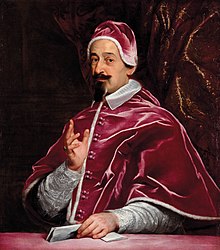Alexander VII | |
|---|---|
| Bishop of Rome | |
 Portrait by Giovanni Battista Gaulli | |
| Church | Catholic Church |
| Papacy began | 7 April 1655 |
| Papacy ended | 22 May 1667 |
| Predecessor | Innocent X |
| Successor | Clement IX |
| Previous post(s) |
|
| Orders | |
| Ordination | December 1634 |
| Consecration | 1 July 1635 by Miguel Juan Balaguer Camarasa |
| Created cardinal | 19 February 1652 by Innocent X |
| Personal details | |
| Born | Fabio Chigi 13 February 1599 |
| Died | 22 May 1667 (aged 68) Rome, Papal States |
| Motto | Montium custos (Latin for 'Mountain guardian') |
| Signature | |
| Coat of arms |  |
| Other popes named Alexander | |
Pope Alexander VII (Italian: Alessandro VII; 13 February 1599 – 22 May 1667), born Fabio Chigi, was head of the Catholic Church and ruler of the Papal States from 7 April 1655 to his death, in May 1667.[1][2]
He began his career as a vice-papal legate, and he held various diplomatic positions in the Holy See. He was ordained as a priest in 1634, and he became bishop of Nardo in 1635. He was later transferred in 1652, and he became bishop of Imola. Pope Innocent X made him secretary of state in 1651, and in 1652, he was appointed a cardinal.
Early in his papacy, Alexander, who was seen as an anti-nepotist at the time of his election, lived simply; later, however, he gave jobs to his relatives, who eventually took over his administration. His administration worked to support the Jesuits. However, his administration's relations with France were strained due to his frictions with French diplomats.
Alexander was interested in architecture and supported various urban projects in Rome. He also wrote poetry and patronized artists who expanded the decoration of churches. His theological writings included discussions of heliocentrism and the Immaculate Conception.
- ^ Williams, George L. (1998). Papal Genealogy: The Families and Descendants of the Popes. McFarland & Company. p. 114.
- ^ Note on numbering: Pope Alexander V is now considered an anti-pope. At the time however, this fact was not recognised and so the fifth true Pope Alexander took the official number VI. This caused the true sixth Pope Alexander to take the number VII. This has advanced the numbering of all subsequent Popes Alexander by one. Popes Alexander VI-VIII are really the fifth through seventh popes by that name.